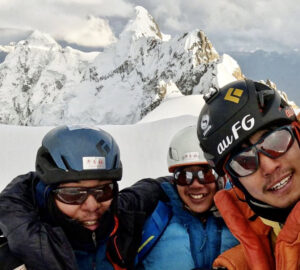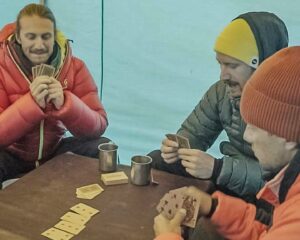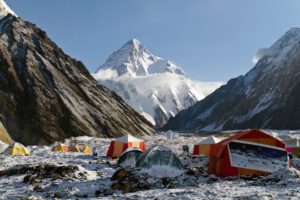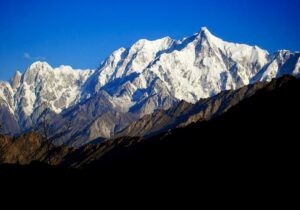The last time anyone stood atop Jammu and Kashmir’s Thajiwas Peak, the world was at war. English mountaineers John Jackson and John Buzzard breeched the prohibitive peak in summer 1945, posting its second ascent months before World War II ended.
Then, the 4,854m summit sat quiet for the next 78 years. That lapse came to an end this month.
Kashmiri climber Zeeshan Mushtaq reported the third ascent of Thajiwas on Friday, July 7. The 23-year-old pursued the feat alongside Faisal Wani, who stopped short of the summit by “hundreds of meters,” according to Wanderlust.
But the two mountaineers’ historical success wasn’t what generated the climb’s first headlines. Instead, a rescue they required on the descent did.
The Indian Air Force rescued the two mountaineers on their way down Glacier 2, nestled in the same couloir they’d climbed to access the peak. Adverse weather and surface conditions led to an injury to Wani and a dicey standstill as temperatures dropped on the descent. They called for help. And while the rescue efforts succeeded, the story precluded news of the ascent itself.
“As news about our rescue surfaced all over, the story about our historic climb of Thajiwas remained untold and unreported,” Mushtaq said in a July 8 Instagram story.
Now following a detailed report he provided to Dream Wanderlust, the cat’s out of the bag.
One out of two ain’t bad
Mushtaq and Wani lit out for the peak from nearby Sonamarg at 10:30 am on July 1. They climbed alpine style, he told Wanderlust, but still ended up moving slowly. Because no one had climbed Thajiwas via the “Great Couloir” since Jackson and Buzzard almost eight decades before, they were effectively breaking new ground.
(In the post below, “Glacier 2” leads to the Great Couloir and Thajiwas Peak past the feature marked “The Blade/Arrow.”)
View this post on Instagram
Still, the climb proceeded more or less smoothly. Base camp established, the two men dispatched the glacier climbing without incident. An impassible crevasse separated the glacier from the couloir proper (and thus, access to the summit) and forced a detour.
Relative peril waited above. The 300m couloir climb is a significant obstacle to any Thajiwas hopeful — the 70˚ snow varied wildly in quality due to unreliable weather, Mushtaq advised.
View this post on Instagram
“The snow was so soft in places that it made it difficult to gain traction. The ice axe could not be used to secure the surface,” Mushtaq noted.
Continuing undeterred, he wrote, “As we rose in elevation, the views became breathtaking. The majestic Nanga Parbat could be seen from our vantage point, and the vast array of mountains provided a picturesque scene.”
The final pitches required mixed climbing. Mushtaq pressed on after Wani halted for unreported reasons 300m shy of the top. “Braving” this last passage alone, he summited at 11:30 am on July 2 — just over 24 hours after leaving Sonamarg.
“I pushed my body to its absolute limits. Every step tested my endurance, every breath was a reminder of the thin air challenging my lungs and every muscle screamed in protest,” he wrote on Instagram. “Yet amidst the struggle, I found a wellspring of determination that propelled me forward.”
Climbers, temperatures plummet
The expedition’s main ordeal was yet to come. Mushtaq said the climbers planned to reverse their route “as quickly as possible.” But the oncoming heat of the afternoon destabilized the snow and, terrifyingly, the climbers slipped and began sliding uncontrollably.
Wani came to rest below with a leg injury severe enough to halt the group. Hypothermia began to set in. Mushtaq called for a rescue and switched to survival mode.
“I had to take quick and decisive action to protect my partner from the cold. I used my own body heat, as well as clothes, to keep him warm. We stayed calm and waited for the rescue team to arrive,” Mushtaq said.
He and Wani stayed stuck for four hours. Once rescuers responded, the whole group descended to base camp safely, Wani in a stretcher. But hypothermia threatened the injured climber increasingly, Mushtaq worried, so he called in helicopter evac.
Since landing safely in hospital care, Wani has made a “full recovery,” according to Dream Wanderlust.
While he escaped with his life, his climbing partner took home the glory.
“The climb was difficult and taxing, both mentally and physically,” Mushtaq acknowledged. “At the top, the magnificent views of the majestic mountains and valleys gave [me] a sense of accomplishment and pride. I am deeply grateful for the help we received as well as the fact that both of us managed to come out unscathed.”
Or close to it. Route information detailed enough to aid a repeat effort has yet to surface and, due to the mountain’s capricious nature, might never do so — whether we’re talking tomorrow or 78 years from now.






